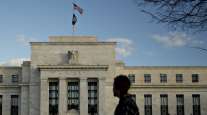Senior Reporter
Economic Recovery Threatened by COVID-19 Resurgence, Experts Say

[Ensure you have all the info you need in these unprecedented times. Subscribe now.]
The U.S. economy, which had begun to show signs of a recovery in June, is now in jeopardy of stalling amid rising cases of COVID-19 infections in densely populated states such as California, Texas, Florida and Georgia, and a lack of social distancing.
Bob Costello, chief economist at American Trucking Associations, made that projection during the inaugural edition of Transport Topics Newsmakers — available at TTNews.com/Newsmakers.
“Early indicators are showing how fast the economy was snapping back. But the number of cases that we are seeing with COVID-19 going up is very concerning to me, and I think that is a real threat to this recovery,” Costello said.

Costello
“We have data that shows U.S. consumer foot traffic at different types of businesses — auto dealerships, big-box retailers, malls, restaurants. And except for big-box retailers, they really came up when things were improving, when the cases went down. But now you’re seeing movement the other way again,” Costello continued. “There were a lot of people getting together in groups. But the biggest threat to this recovery is that this pandemic gets worse.”
In the past several weeks, a number of states have taken steps to slow or stop reopening their economies after the surge in cases.

Newsom
California Gov. Gavin Newsom announced July 13 all bars must close, and restaurants, wineries, tasting rooms, family entertainment centers, zoos and museums must suspend indoor activities. Also, gyms, places of worship, shopping malls, personal care services, barbershops, salons and noncritical offices in the counties on the state’s “monitoring list” had to shut down under the new order.
“We’ve made this point on multiple occasions, and that is, we’re moving back into a modification mode of our original stay-at-home order,” Newsom said during a news conference. “This continues to be a deadly disease.”
In March, California became the first state to impose a mandatory stay-at-home order to slow the spread of the virus.

Brainard
Additionally, Federal Reserve Governor Lael Brainard warned during a webinar July 14 that the U.S. economy could slow after a quick burst of recovery in May and June. Brainard is also calling for more aggressive action by the Fed to keep the economy moving forward to avoid a double-dip, or W-shaped recession, where the economy shrinks after expanding.
“Rolling flare-ups or a broad second wave of the virus may lead to widespread social distancing — whether mandatory or voluntary — which could weigh on the pace of the recovery and could even presage a second dip in activity,” Brainard said. “Some high-frequency indicators tracked by Federal Reserve Board staff ... suggest that the strong pace of improvement in May and the first half of June may not be sustained.”
Still, most trucking sectors are doing well, Costello said.
“It just depends on what supply chain you’re in and what part of the country you’re in,” he said. “As an industry, we can do a little bit better than the rest of the overall economy. Understanding that those industries getting hit hardest tend to be on the services side, and those are less truck-intensive industries than say retail goods, housing starts, and construction and industrial production.”
Costello said he’s forecasting a drop in second-quarter gross domestic product of 35% on an annual basis, and depending on how bad the pandemic continues to hit densely populated states, an increase of 15% in GDP in the third or fourth quarter.
Meanwhile, DAT Freight and Analytics on July 10 reported spot market rates and volumes increased across all equipment types as the online marketplace for spot truckload freight expects demand to return to seasonal trends.
In June, van, reefer and flatbed results ended in positive territory when measured year-over-year and month-over-month.
The DAT Truckload Volume Index, a measure of dry van, refrigerated and flatbed loads moved by truckload carriers, was up 9.4% compared with June 2019 and up 13.7% compared with May.
The DAT Truckload Volume Index, a measure of dry van, refrigerated (“reefer”) and flatbed loads moved by truckload carriers, rose 13.7 percent from last month, a 9.4 percent increase over June 2019. https://t.co/gSLmLV9lBK #trucking #logistics #supplychain — DAT Freight & Analytics (@LoadBoards) July 10, 2020
Spot van rates averaged $1.80 per mile nationally, up 21 cents compared with May but down 9 cents compared with June 2019.
The national average reefer spot rate was $2.15 per mile, up 13 cents compared with May but 9 cents lower year-over-year.
“The surge we’re seeing in spot truckload rates and volumes is consistent with summer trends, but consumer habits continue to be impacted by COVID-19,” said Ken Adamo, chief of analytics at DAT. “For instance, there’s been an early increase in demand for pressure-treated lumber as people tackle home improvement projects. But produce growers and distributors are contending with soft restaurant demand as states reopen at different speeds with different rules.”
Want more news? Listen to today's daily briefing:
Subscribe: Apple Podcasts | Spotify | Amazon Alexa | Google Assistant | More




